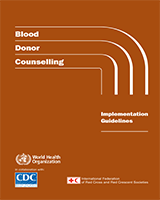Although it is hoped that no donor will have any ill-effects from giving blood, occasionally bruising of the arm may develop at the venepuncture site. The bruise can look dramatic and some people may find this worrying, but it is usually harmless and recovers within a few days.
Bruising is caused by bleeding under the skin, which occurs due to injury to blood vessels. These injured blood vessels leak a small amount of blood, which collects in the area as a bruise. If a bruise occurs during blood donation, the process may be discontinued to prevent it from worsening. With time, the familiar blue-black discolouration changes to green, then yellow and eventually fades and disappears. This may take two to three weeks if the bruise is large. It is normal for bruises to spread out before fading.
During or after blood donation, the following may happen:
The vein is pierced during blood donation, causing some blood to leak into the surrounding tissue. The donor is more likely to develop a bruise if the venepuncture procedure was more difficult than usual.
There are tiny fragile blood vessels running just under the skin, as well as the larger veins from which the blood donation is obtained. When the donation needle is inserted into the arm, one of these small vessels may be injured and bleeding occurs.
Inadequate pressure placed on the venepuncture site after removal of the needle may allow blood to leak in the surrounding tissues.
Lifting heavy objects after blood donation could put pressure on the venepuncture site and dislodge the clot formed.
Prevention and management of bruising following blood donation
Wear clothes with loose fitting sleeves when donating blood. A tight sleeve can act as a tourniquet and cause congestion in the vein, increasing the chance of bruising.
Apply firm pressure to the venepuncture site after donation, as advised by the BTS staff member, until the bleeding has stopped. A plaster will be applied to cover the venepuncture site; this should be kept on for a minimum of six hours.
Avoid lifting heavy objects for a few days as this could aggravate the bruising. However, gentle movements are recommended whilst the bruise is healing.
If bruising has developed, applying cold compresses to the area can also help to relieve any pain or discomfort.
If you require more pain relief, it is recommended to take paracetamol (according to the manufacturer's instructions); avoid taking aspirin or ibuprofen for the first 24 hours.
If you experience any of the following, seek further help or call the BTS for advice:
- —
Severe pain
- —
Numbness or persistent ”pins and needles” in the arm, hand or fingers
- —
Swelling which is large or increasing in size
- —
Painful redness and inflammation.

